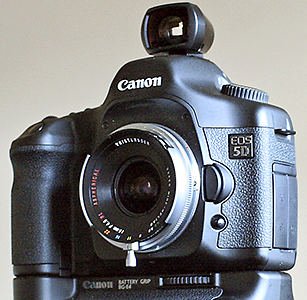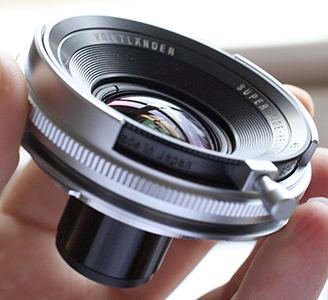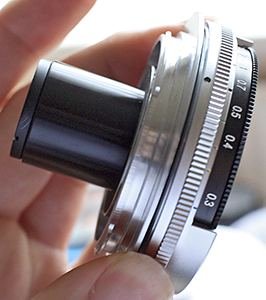Voigtlander Super Wide Heliar 15mm f4.5
v Sigma 12-24mm f4.5-5.6

The Canon 5D/Voigtlander Rangefinder


The Voigtlander 15mm f4.5. Where on earth are you going to put THAT?
First things first: yes, you can use Voigtlander's true wide angle lenses on Canon digital cameras: here's my 15mm f4.5 SL on an EOS 5D. They also make a very nifty 12mm rectilinear (more on this later). For mounting details, please see the footnote at the end of the article.
Behind the lens (in fact, about 15mm behind the rear element) is a state of the art picture taking computer temporarily retarded to the complexity of a box brownie. You can't use the optical finder because there's a lens where the mirror should be. You can't use the metering because there's a lens where the mirror should be. And you can't autofocus because this is the 1920s. But you can take pictures.
Other than sheer bloody-minded perversity, why would you want to do this? Because these little rangefinder optics are not inside-out telephoto lenses. When Voigtlander say the 15mm SL is rectilinear, they really, really mean it, to a degree that retrofocus SLR optics can't approach. Rangefinder wide angles are much simpler to design, and have exit elements much closer to the film or sensor plane, making corner sharpness and field flatness much easier to achieve. Oh, and they are cheap!
It is generally agreed that the finest wide angle lenses are the Mamiya 7 43mm and the Zeiss Biogons. Anyone who has used either, especially those currently struggling to shoot architecture with a Canon 1Ds II, tend to come over all wistful and nostalgic at the very mention of their name. But can the Voigtlander Super Wides bring some of their ancient rangefinder voodoo to the age of digital capture? Can they slay the three-headed dragon of distortion, inadequate resolution and chromatic aberration? Or will the quest for wide angle image quality prove too perilous for even these exotic creatures? Let the trials commence....
Continue to Page Two...
Tests conducted with Canon 5D at ISO50 shot RAW with mirror lock up and processed via Capture One 3.7.3 into 8-bit Adobe RGB, sharpened in PhotoShop (150/0.5/4) and converted for web with BoxTop ProJPEG. All captures manually focus bracketed.